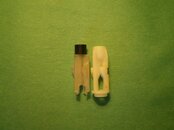I played around with bending the feet on my bad breathing R109 lever and got the cracking effort down to about 1.25". I lowered the angle of the feet resulting in the lever being slightly lowered when installed. I'd like to go further and see what happens, but I don't want to damage this lever until I can find a new lever. Now it breaths pretty well, but I'm sure it can do a little better. I tried switching out diaphragms, but it really didn't make much of a difference. Changing them did require an adjustment on each orifice because of the difference in diaphragm height.
So, things are improving and I'm learning a lot. All the on and off again with the cover took its toll on the old rubber purge disc and I'll be needing a new one of those too. The good news is that I seem to be on the right track.
Thanks everyone.
Please just stop.
Removing a lever from a 109 (or any other SP air barrel) should be a very rare thing as each time you remove it and re-install it you run the risk of bending or at least weakening the arms of the lever.
Bending the feet on the lever is a major no-no and don't worry about ruining the lever - you already have.
The sad part here is that there seems to be some really bad advice on adjusting lever height with a focus on a specific distance above the case etc that is borrowed from other entirely different designs (US Divers, etc.)
With the 109, what matters is that:
1. You pre-set the orifice about 1.5 turns out from all the way in
2. Assemble the reg including the poppet, spring and spring pad (I won't mention the lever as it should have never been removed, but it should be checked while still installed in the air barrel to ensure the arms are not bent and the feet are still parallel) and then install the diaphragm and purge covers.
3. Adjust the orifice until the reg just stops freeflowing and then turn it in another 30 degrees (from 12 o'clock to 1 o'clock).
4. Check the adjustment and lever height. Ideally, if the spring is pressure is still correct, you will have a reg that delivers an inhalation effort within spec and that has a lever height such that a slight depression of the purge initiates air flow.
Assuming the lever is compatible with the poppet and those parts as well as the orifice are in good condition - if the inhalation effort is still too high, it reflects an excessively stiff spring and the solution here is a different spring.
The solution is NOT bending the lever or trying some other kluge of a fix to correct the "problem".
----
My concern here is simple - if you screw up the lever (or if it is poorly fitted/ not compatible with the poppet) it can jump over the poppet and cause the reg to fail closed. That is a very serious and potentially deadly failure.
As such, all the lever height discussion is well intended but potentially dangerous when people start trying to hit a target height with a disassembled reg in a single adjustment system where proper component relationships and spring pressure in the assembled reg are the real keys to proper lever height and successful adjustment.
-----
Another issue here is that some of the 109s out there are now 40 years old and some of them (including some far younger than that) have been used hard and are no longer going to perform the way they should. Those 109s often have critical components that need to be retired, and in some cases the cases are worn to the point that the reg needs to be retuired. When I hear about one that won't perform, it occurs to me that there is a reason for that, and that absent proper replacement parts and a degree of expertise to diagnose and fix the situation
correctly , the reg needs to be retired from service.





